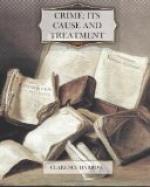Dugdale’s figures of delinquency in the Jukes family are doubtless much too high. A large percentage of facts was gained from gossip and hearsay about those long since dead. The details show that many crimes charged were not even proved, others were evidently not crimes, and in any small community suspicion would rest upon a member of this family who was accused. Then too, the poor in court and out have a hard time defending themselves. They are frequently convicted when accused. The evidence in regard to the subnormal and defective is still less satisfactory. Without close examination and thorough tests, illiteracy generally passes as subnormality. Very few of the subjects were submitted to a careful test. It is at least probable that this family was not much different from the other families who lived in like circumstances in the community.
Dugdale’s original examination covered 709 cases out of about 1200 that were supposed to be living at the time. Of this number, 180 are put down as having received institutional and outdoor relief. The criminals and offenders are put down at 140. Habitual thieves convicted and unconvicted are listed at 60. Common prostitutes are put down at 50.
After Dugdale’s investigation the family, from industrial and other conditions, became scattered and spread out over many states. A record has lately been made of the descendants of this family, the later record showing much improvement in the stock. This must be due to environment. It seems fairly certain that with time and opportunity, it will not much longer be a marked family.
Quite aside from the history, it seems certain that no results such as shown by Dugdale could have followed from inheritance. Defectiveness is a recessive factor; normality a dominant one. If such were not true, this would be a world of feeble-minded. If the Mendelian law held good in this regard, from a union of a defective and a normal person, three out of four would be normal, but as a matter of fact, the percentage of normal is no doubt much greater. It is only when both father and mother are feeble-minded that feeble-mindedness is sure to show in the offspring. With the modern care of this sort of defectives, the chance of breeding is growing rapidly less.
The Kallikak family is cited as another illustration showing the possible inheritance of criminality and poverty through a defective strain. This family, so far as shown, makes it still clearer that what some authors have charged to heredity is simply due to environment. These investigations do not show the need of controlling birth but do prove the necessity of improving environment. It is not possible to speak with certainty as to heredity and environment. The thorough investigation of these two factors which make up life is still in its infancy, but scientists are working out the problem, and we may be confident that with the right attitude toward crime, a remedy will be found for such cases as result from environment.




